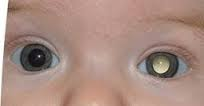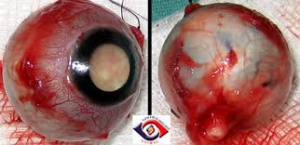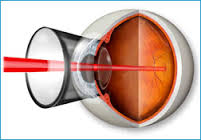 Retinoblastoma
Retinoblastoma
Retinoblastoma is a cancer of the eye in children. It originates from the retina, the light sensitive layer, in eye. It is the commonest eye tumor of the eye in childhood. . This tumor may involve one (75% of cases) or both (25% of cases) eyes in a child. Untreated, retinoblastoma is almost always fatal, hence the importance of early diagnosis and treatment
Is it hereditary?
Yes in some cases it may be hereditary. Majority of cases (90%) has no family history of such disease; while a small percentage (10%) of newly diagnosed cases have other family members with retinoblastoma.
Of all the cases of retinoblastoma, in 60% of cases it does not get transmitted to the next generation, while in 40% of cases it may get transmitted in the next generation. Therefore it is important to have a genetic counseling before having a baby to determine the risk of another child getting the same disease. Also, the siblings and children of the patients with retinoblastoma should be examined periodically in their childhood to detect any possible tumor early.What are the symptoms of retinoblastoma?
As the child does not complain of any poor vision, the tumor may remain undetected. The most common way of presentation is a white reflex (leukocoria) behind the pupil. This is sometimes called the cat’s eye reflex. There may be other causes of this white reflex as well, but an evaluation by an ophthalmologist is a must in all these children to rule out the possibility of this serious and potentially life threatening disease.
It may also present as squint (crossed eye), poor vision, painful red eye, inflammation of the tissue surrounding eye, protrusion of the eye ball (proptosis) etc. Occasionally it is detected on a routine eye checkup by an ophthalmologist, especially in a child with family history of this disease.
If a child has been diagnosed to have retinoblastoma in one eye, can he also develop the same disease in the other eye?
Yes. 25% of these tumors can affect both the eyes. The other eye must also be evaluated thoroughly for the presence of any tumor. Also in a few cases, the other eye may develop tumor a bit later. Therefore on the follow up visits also, the other eye should be examined.
Is the child also at a risk for other diseases or tumors?
Some of these children, especially those in which the tumor involves both the eyes, are at a risk for developing other tumors like osteogenic sarcoma (a cancerous tumor that affects the bone). The radiation therapy for the tumor (external beam radiotherapy) increases this risk of other tumors. Your ophthalmologist will discuss these issues with you
My child has been diagnosed to have retinoblastoma. Should I get my other children examined as well?
As we know, a few of these cases may be hereditary, therefore all the siblings of the affected child must get an evaluation to rule out this disease.
What are the chances that the next child to be born would have the same disease?

These chances may range from as low as 1 in 15,000 to as high as 45%, and depend upon many factors and like whether there is a family history of such tumor, whether the tumor is involving both eyes etc. A genetic counseling should be sought when planning for another baby. Similarly, when a person with treated retinoblastoma plans to have a child, he or she must also consult the doctor for genetic counseling.
Is it curable?
Yes. If detected at an early stage, the life and many times the sight and the eye of the child may be saved. After removal of the tumor, the chances of survival are very good in these children.
What are the treatment options?
The aim of treatment in retinoblastoma, in order of priority, is to save the life, eye, sight and cosmesis of the child.
There are many treatment modalities for this tumor. These are:
-
-
-
-
 Enucleation: This means removal of the eye. The eye with the tumor is removed and is sent for a pathology report. The space is replaced by an artificial implant made of plastic, rubber or coral. The child is fitted with prosthesis or artificial eye, made to match the other eye. This artificial eye, of course, does not have any vision.
Enucleation: This means removal of the eye. The eye with the tumor is removed and is sent for a pathology report. The space is replaced by an artificial implant made of plastic, rubber or coral. The child is fitted with prosthesis or artificial eye, made to match the other eye. This artificial eye, of course, does not have any vision. - External beam radiation: as an alternative to enucleation, this method of giving radiation treatment to the eye may treat the tumor while preserving the eye. As the tumor is very radiosensitive, this treatment method is very effective. Though the radiation may cause damage to the surrounding structures of the eye, e.g., lens (cataract), lacrimal system (dry eye), orbit (bone maldevelopment) etc. It also increases the chance of developing secondary tumor of the bone, especially in children with tumor involving both eyes.
- Localized Plaque radiation therapy: This method involves applying radioactive plaque close to the tumor on the sclera, and thus gives the radiation therapy in a localized area. It significantly decreases the local complications associated with radiation therapy.

- Photocoagulation: Laser treatment for the tumor is effective and safe for tumors that are smaller in size. In the right cases, this treatment may help in preserving eye as well as the sight of the child.
- Cryotherapy: this involves freezing of the tumor by applying a special probe on the external surface of the eye (sclera). This treatment is done under direct observation and is effective in saving the eye and sight in patients with small tumor.
- Chemotherapy: Treatment with anticancer drugs. There has been a recent preference towards treatment with systemic drugs as an additional treatment. The chemotherapy may decrease the size of the tumor and thus make it more amenable to local treatment like laser, cryotherapy and plaque radiation.
-
-
-
Which treatment option is the best?
The treatment of retinoblastoma is individualized for each patient. The treatment modality for a given child is decided based on many important factors. These are:
-
-
-
- Size of the tumor
- Location of the tumor
- Whether the tumor has spread
- Status of the other eye
- Associated complications like retinal detachment, glaucoma
- Family history
- The wishes and concerns of the parents
- Availability of the facilities
-
-
As this is a difficult decision made based on many factors, it is advised to discuss with the treating ophthalmologist about the best treatment option for the concerned child. All the advantages and disadvantages of each option must be weighed before taking a decision. It is also important to discuss the rehabilitation and the cosmetic correction after the surgery.
What is done if the child has tumor in both eyes?
In these cases, generally the worse eye is enucleated and the other eye is tried to salvage by using other methods of treatment. However, unfortunately in a few cases, both eyes may have to be removed.
Why is early detection important?
As mentioned earlier, the safer and less destructive procedures may be taken when the tumor is in its early stage. By detecting and treating the tumor early, we may save the life, sight and eye of the child.
What are the long-term consequences of retinoblastoma?
Even though retinoblastoma is a life threatening disease, it is rarely a fatal one if treated appropriately. With the correct treatment in the hands of an experienced ophthalmologist, the retinoblastoma patient has a very good chance of living a long, full, and happy life.
It is very important to have a proper follow up with the treating ophthalmologist for the eye tumor as well as for detection and treatment of possible other tumors. The frequency of follow up depends upon the type of tumor and the type of treatment given. Also in children with only one eye left, extra care must be taken to avoid injuries to the good eye.
